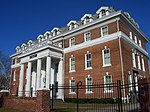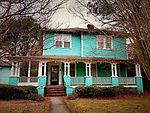Chappelle Administration Building

The Chappelle Administration Building, on the campus of Allen University in Columbia, South Carolina, was designed by John Anderson Lankford, known as the "dean of black architects." The building name has been spelled Chapelle Administration Building in HABS and NPS reports. It was declared a National Historic Landmark in 1976, cited as one Lankford's most important works.In addition to its National Register of Historic Places status, the Administration Building falls within the boundaries of Waverly Protection Area, a Preservation District within the City of Columbia Urban Design and Historic Preservation District system. This Preservation District is an expansion of Waverly Historic District.
Excerpt from the Wikipedia article Chappelle Administration Building (License: CC BY-SA 3.0, Authors, Images).Chappelle Administration Building
Harden Street, Columbia Waverly
Geographical coordinates (GPS) Address Phone number Website Nearby Places Show on map
Geographical coordinates (GPS)
| Latitude | Longitude |
|---|---|
| N 34.010972222222 ° | E -81.020833333333 ° |
Address
Allen University
Harden Street 1530
29204 Columbia, Waverly
South Carolina, United States
Open on Google Maps










